Aircraft Observations of Characteristics and Growth of Ice Particles of Two Different Snowfall Clouds in Shanxi Province, China
Abstract
1. Introduction
2. Synoptic Situation
3. Field Study and Instrumentation
4. Microphysical Structure of Clouds
4.1. Ice Particle Image Analysis
4.2. Vertical Distribution of Microphysical Characteristics of Snowfall Clouds
4.2.1. Cumulus Mixed Cloud Snowfall on 29 November 2011
4.2.2. Stratiform Cloud Snowfall on 3 March 2012
4.3. Spectral Parameters of the Ice Snow Crystal Spectrum
5. Conclusions
Author Contributions
Funding
Data Availability Statement
Conflicts of Interest
References
- Baker, B.A.; Lawson, R.P. In situ observations of the microphysical properties of wave, cirrus, and anvil clouds. Part I: Wave clouds. J. Atmos. Sci. 2006, 63, 3160–3185. [Google Scholar] [CrossRef]
- Letu, H.; Ishimoto, H.; Riedi, J.; Nakajima, T.Y.; Labonnote, L.C.; Baran, A.J.; Nagao, T.M.; Sekiguchi, M. Investigation of ice particle habits to be used for ice cloud remote sensing for the GCOM-C satellite mission. Atmos. Chem. Phys. 2015, 15, 31665–31703. [Google Scholar]
- Letu, H.; Nagao, T.M.; Nakajima, T.Y.; Jerome, R.; Ishimoto, H.; Bran, A.J.; Shang, H.; Sekiguchi, M.; Kikuchi, M. Ice cloud properties from Himawari-8/AHI next-generation geostationary satellite: Capability of the AHI to monitor the DC cloud generation process. IEEE Trans. Geosci. Remote Sens. 2019, 57, 3229–3239. [Google Scholar] [CrossRef]
- Rottner, D.; Vali, G. Snow crystal habit at small excesses of vapor density over ice saturation. J. Atmos. Sci. 1974, 31, 560–569. [Google Scholar] [CrossRef][Green Version]
- Korolev, A.V.; Isaac, G.A.; Hallett, J. Ice particle habits in stratiform clouds. Q. J. R. Meteorol. Soc. 2000, 126, 2873–2902. [Google Scholar] [CrossRef]
- Field, P.R. Aircraft Observations of Ice Crystal Evolution in an Altostratus Cloud. J. Atmos. Sci. 1999, 56, 1925–1941. [Google Scholar] [CrossRef]
- Magono, C.; Lee, C.W. Meteorological classification of natural snow crystals. J. Fac. Sci. 1966, 2, 321–335. [Google Scholar]
- Holroyd, E.W. Some techniques and uses of 2D-C habit classification software for snow particles. J. Atmos. Ocean. Technol. 1987, 4, 498–511. [Google Scholar] [CrossRef]
- Bailey, M.; Hallett, J. Growth rates and habits of ice crystals between −20 and −70 °C. J. Atmos. Sci. 2004, 61, 514–544. [Google Scholar] [CrossRef]
- Bailey, M.P.; Hallett, J. A comprehensive habit diagram for atmospheric ice crystals: Confirmation from the laboratory, AIRS II, and other field studies. J. Atmos. Sci. 2009, 66, 2888–2899. [Google Scholar] [CrossRef]
- Heymsfield, A.J.; Bansemer, A.; Poellot, M.R.; Wood, N. Observations of ice microphysics through the melting layer. J. Atmos. Sci. 2015, 72, 2902–2928. [Google Scholar] [CrossRef]
- Erfani, E.; Mitchell, D.L. Growth of ice particle mass and projected area during riming. Atmos. Chem. Phys. 2017, 17, 1241–1257. [Google Scholar] [CrossRef]
- Heymsfield, A.J. Laboratory and Field Observations of the Growth of Columnar and Plate Crystals from Frozen Droplets. J. Atmos. Sci. 1973, 30, 1650–1656. [Google Scholar] [CrossRef]
- Fukuta, N.; Takahashi, T. The Growth of Atmospheric Ice Crystals: A Summary of Findings in Vertical Supercooled Cloud Tunnel Studies. J. Atmos. Sci. 1999, 56, 1963–1979. [Google Scholar] [CrossRef]
- Takahashi, T.; Fukuta, N. Super cooled cloud tunnel studies on the growth of snow crystals between −4 °C and −20 °C. J. Meteorol. Soc. Jpn. 1988, 66, 841–855. [Google Scholar] [CrossRef]
- Hobbs, P.V.; Matejka, T.J.; Herzegh, P.H.; Locatelli, J.D.; Houze, R.A. The mesoscale and microscale structure and organization of clouds and precipitation in midlatitude cyclones. I: A case study of a cold front. J. Atmos. Sci. 1980, 37, 568–596. [Google Scholar] [CrossRef]
- McFarquhar, G.M.; Black, R.A. Observations of particle size and phase in tropical cyclones: Implications for mesoscale modeling of microphysical processes. J. Atmos. Sci. 2004, 61, 422–439. [Google Scholar] [CrossRef]
- Field, P.R.; Hogan, R.J.; Brown, P.R.A.; Llingworth, A.J.; Choularton, T.W.; Cotton, R.J. Parametrization of ice-particle size distributions for mid-latitude stratiform cloud. Q. J. R. Meteor. Soc. 2005, 131, 1997–2017. [Google Scholar] [CrossRef]
- McFarquhar, G.M.; Timlin, M.S.; Rauber, R.M.; Jewett, B.F.; Grim, J.A.; Jorgensen, D.P. Vertical variablility of cloud Hydrometeors in the stratiform region of mesoscale convective systems and bow echoes. Mon. Weak. Rev. 2007, 135, 3405–3428. [Google Scholar] [CrossRef]
- Heymsfield, A.J.; Bansemer, A.; Field, P.R.; Durden, S.L.; Stith, J.L.; Dye, J.E.; Hall, W.; Grainger, C.A. Observations and parameterizations of Particle size distributions in deep tropical cirrus and stratiform precipitating clouds: Results from in situ observations in TRMM field campaigns. J. Atmos. Sci. 2002, 59, 3457–3491. [Google Scholar] [CrossRef]
- Field, P.R.; Heymsfield, A.J. Aggregation and scaling of ice crystal size distributions. J. Atmos. Sci. 2003, 60, 544–560. [Google Scholar] [CrossRef]
- Sekhon, R.S.; Srivastava, R.C. Snow size spectra and radar reflectivity. J. Atmos. Sci. 1970, 27, 299–307. [Google Scholar] [CrossRef]
- Lo, K.; Passarelli, R.E. The growth of snow in winter storms: An airborne observational study. J. Atmos. Sci. 1982, 39, 697–706. [Google Scholar] [CrossRef]
- Woods, C.P.; Stoelinga, M.T.; Locatelli, J.D. Size Spectra of Snow Particles Measured in Wintertime Precipitation in the Pacific Northwest. J. Atmos. Sci. 2008, 65, 189–205. [Google Scholar] [CrossRef]
- You, L.; Wang, S.; Wang, D.; Chi, Y. The microphysical structure of snow cloud and the growth processs of snow in winter in Xinjiang. Acta Meteorol. Sin. 1989, 47, 73–81. [Google Scholar]
- You, L.; Li, Y.; Liu, Y. On the nucleation processes of ice crystal and the collision efficiency between dendritic snow crystal and droplets in natural clouds. Acta Meteorol. Sin. 1992, 50, 232–238. [Google Scholar]
- Chen, W. The multipliation cenerated by dendritic snow crystals collision and aggregation. J. Acad. Meteorol. Sci. 1987, 2, 74–80. [Google Scholar]
- Mitchell, D.L.; Zhang, R.R.; Pitter, L. Mass-Dimensional Relationships for Ice Particles and the Influence of Riming on Snowfall Rates. J. Appl. Meteor. 1990, 29, 153–163. [Google Scholar] [CrossRef]
- Pruppacher, H.R.; Klett, J.D. Microphysics of clouds and precipitation. Kluwer Acad. Publ. Lond. 1997, 18, 687–689. [Google Scholar]
- Lawson, R.P.; Stewart, R.E.; Strapp, J.W.; Isaac, G.A. Aircraft observations of the origin and growth of very large snowflakes. Geophys. Res. Lett. 1993, 20, 53–56. [Google Scholar] [CrossRef]
- Korolev, A.; Sussman, B. A technique for habit classification of cloud particles. J. Atmos. Ocean. Technol. 2000, 17, 1048–1057. [Google Scholar] [CrossRef]
- Zhu, S.; Guo, X.; Lu, G.; Guo, L. Ice Crystal Habits and Growth Processes in Stratiform Clouds with Embedded Convection Examined through Aircraft Observation in Northern China. J. Atmos. Sci. 2015, 72, 2011–2032. [Google Scholar] [CrossRef]

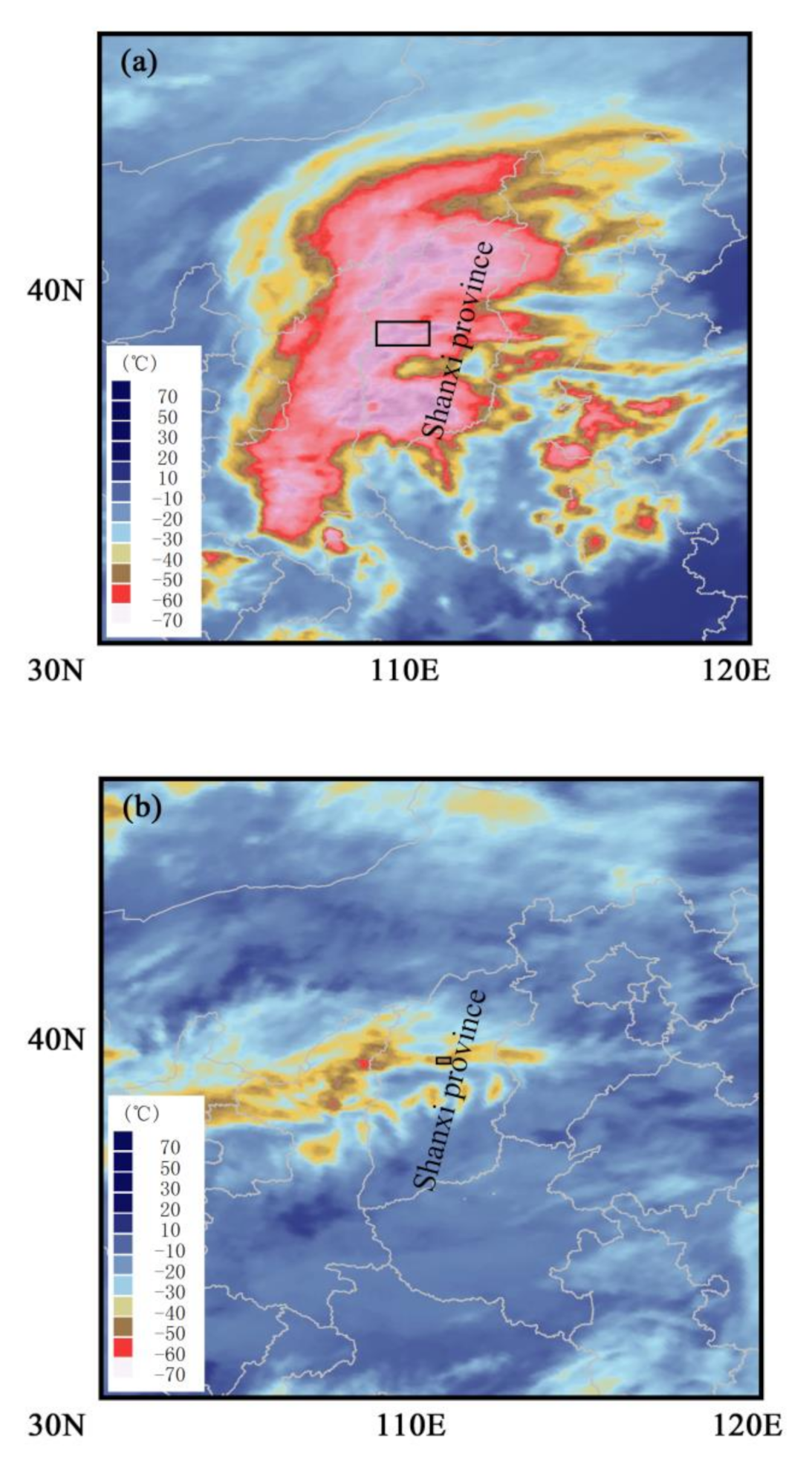
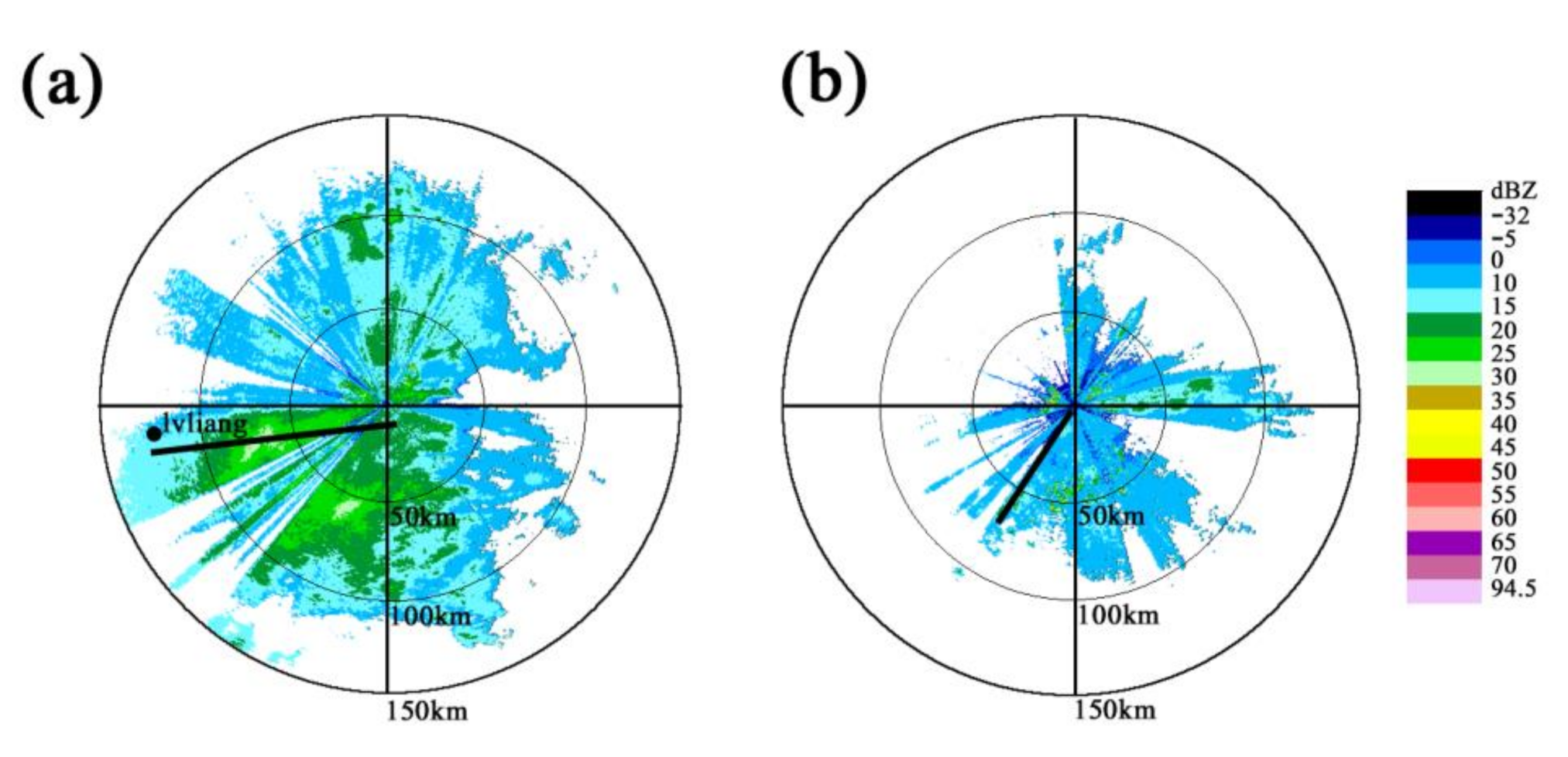
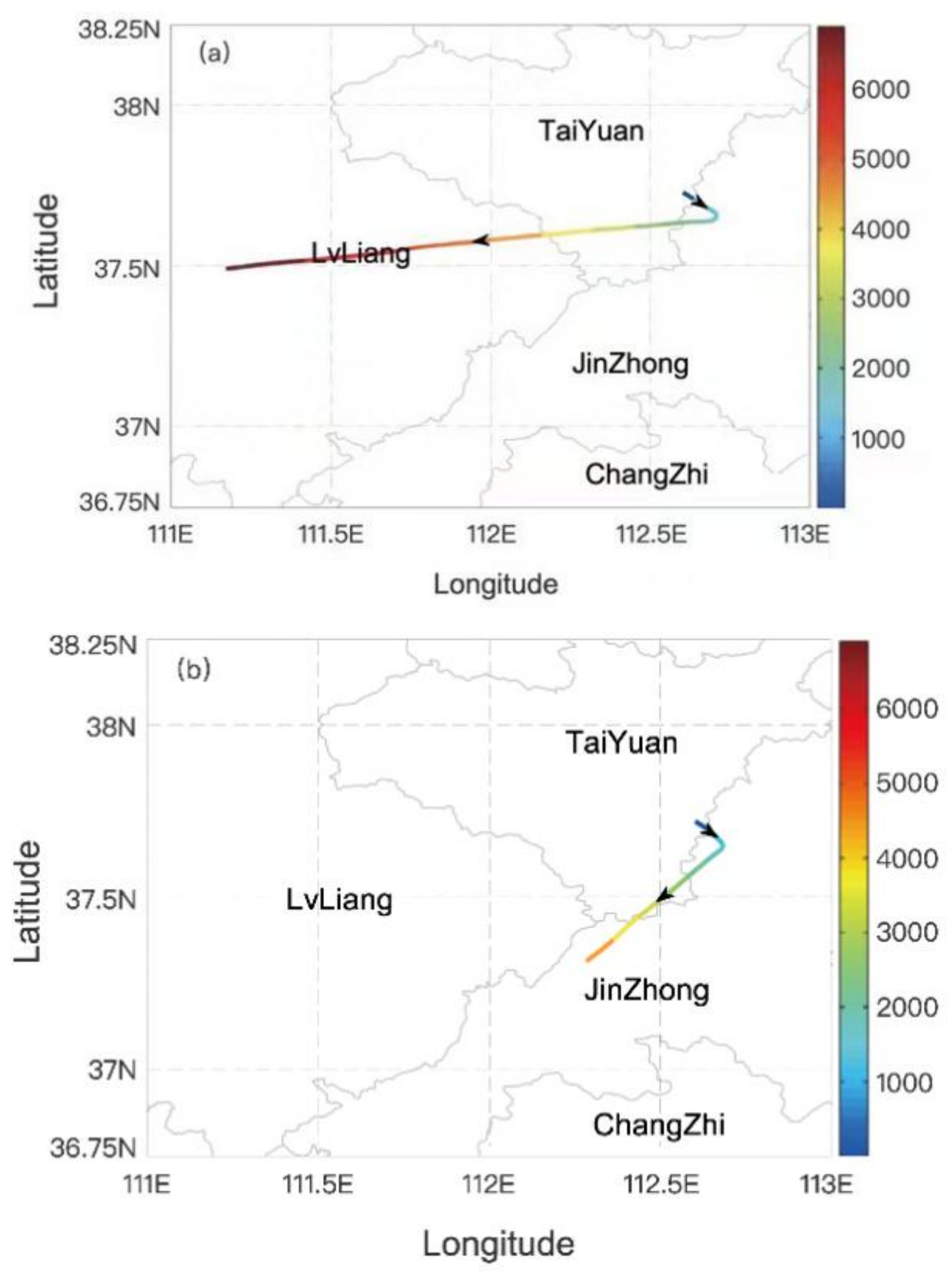
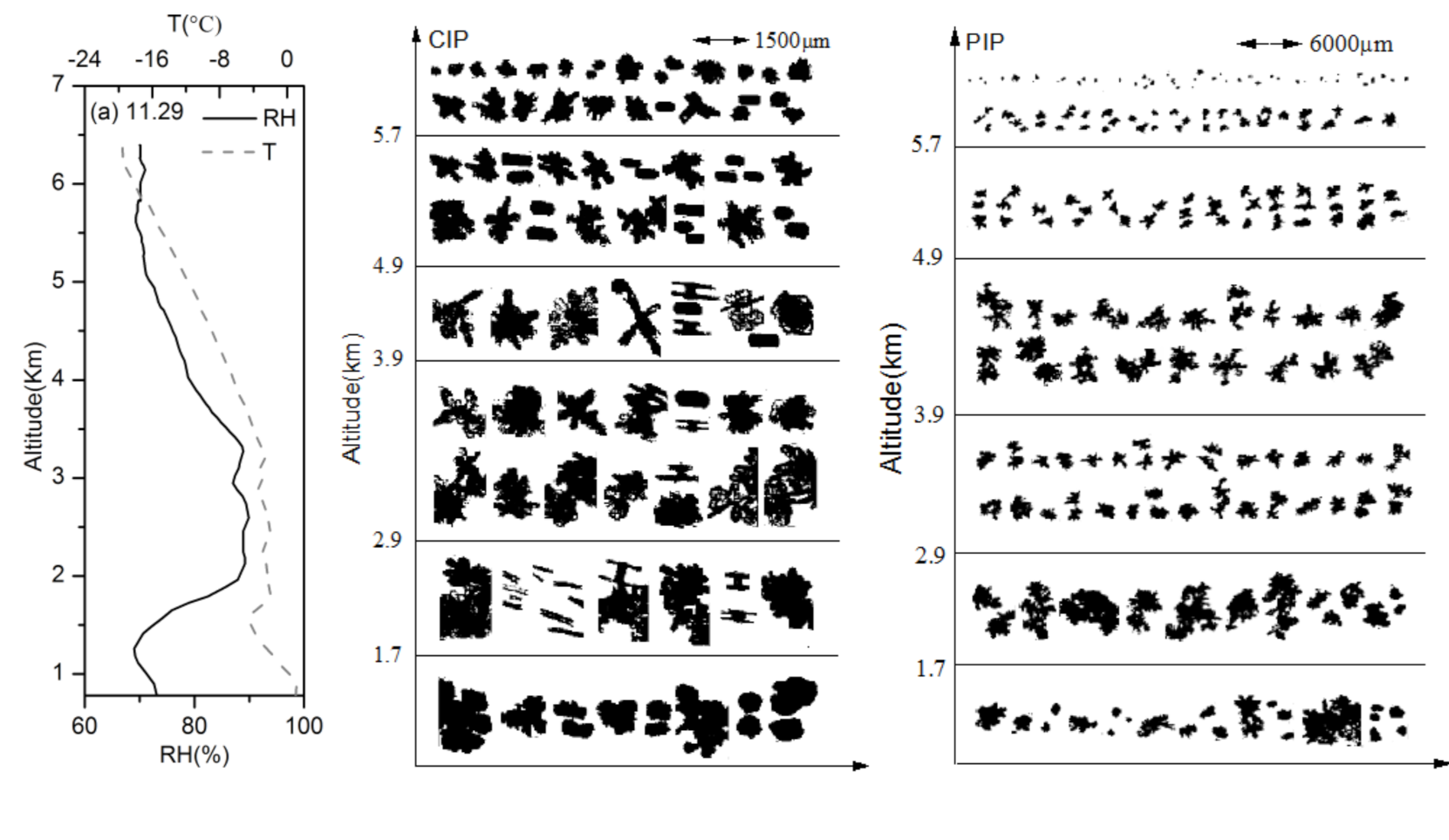
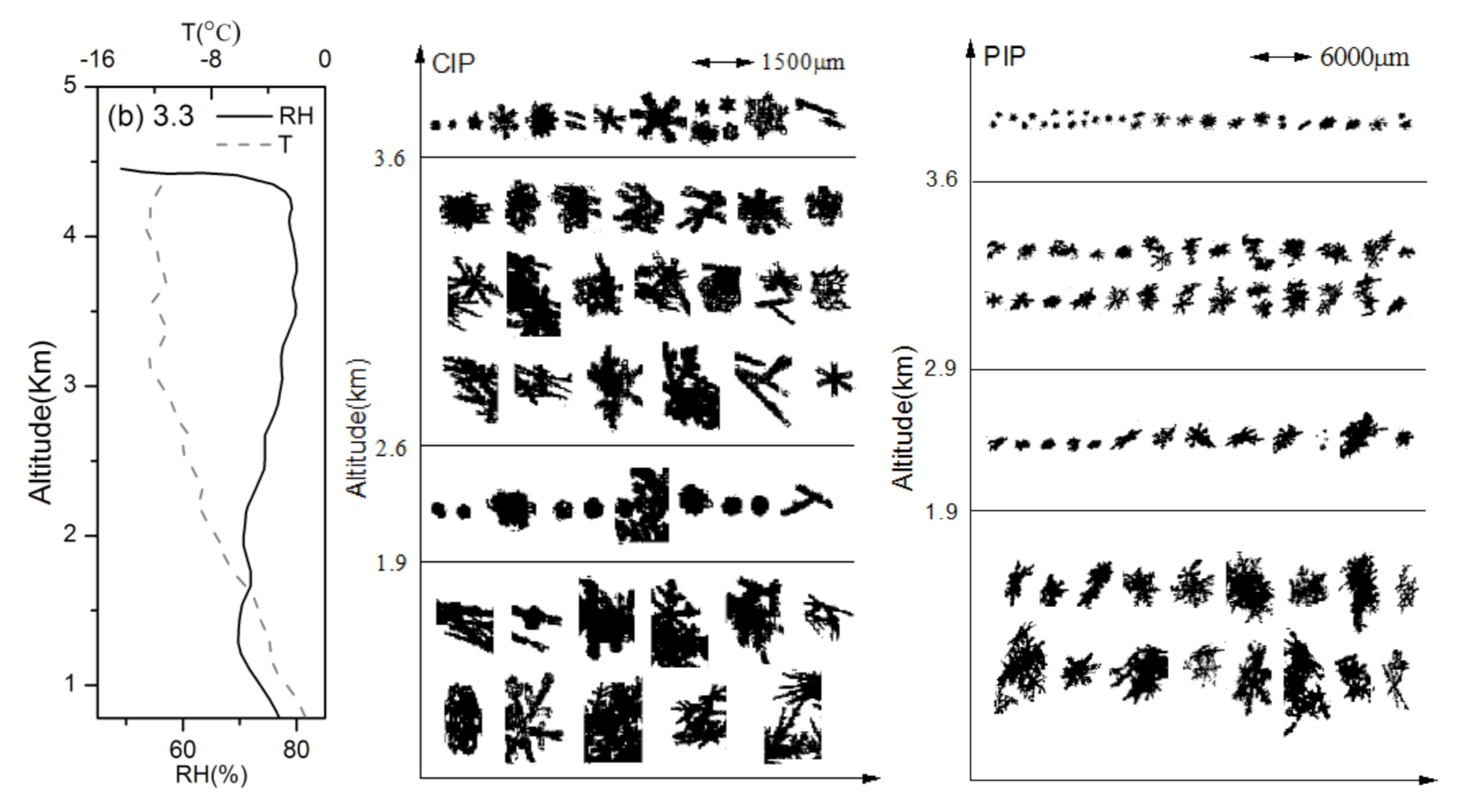
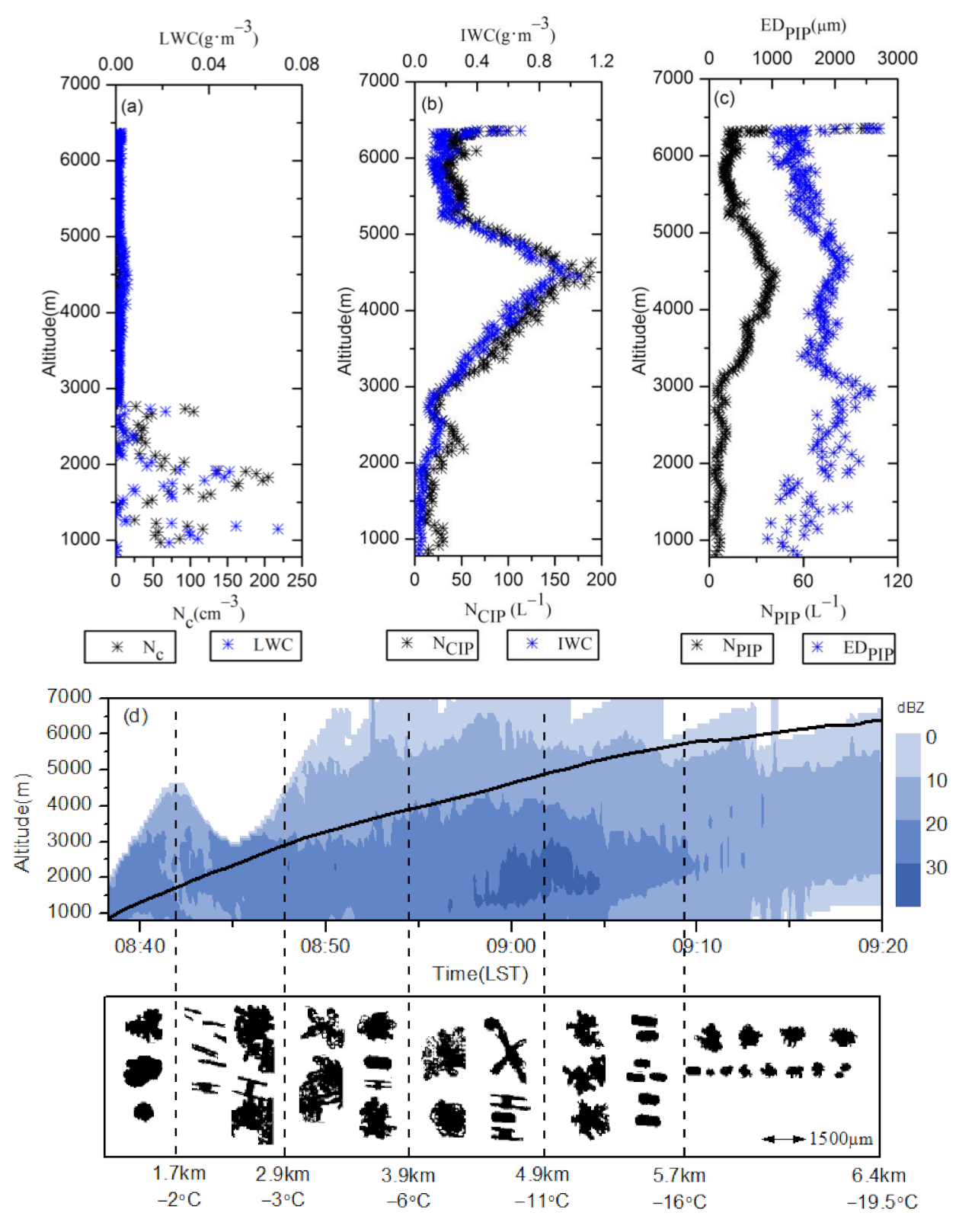
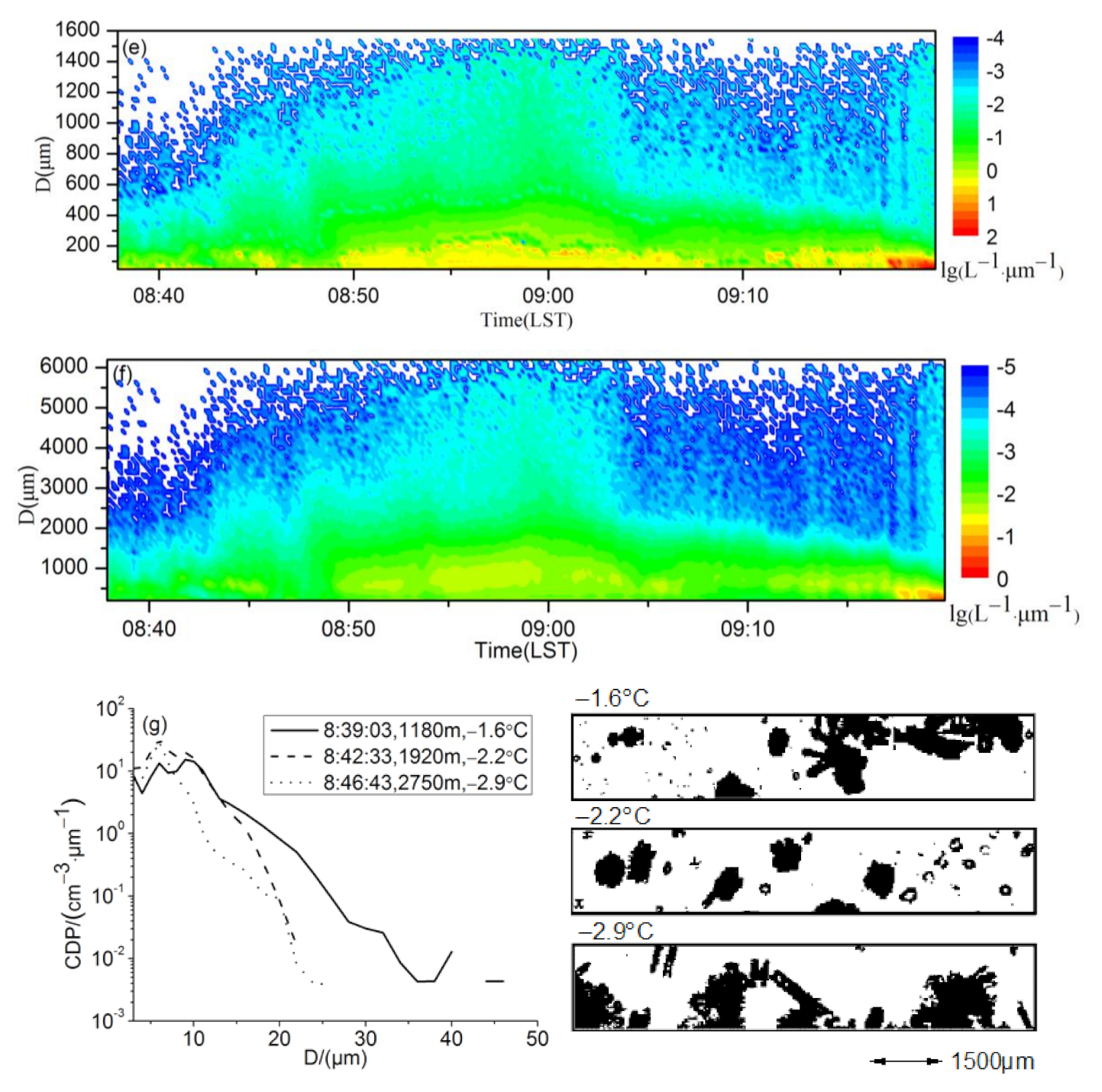
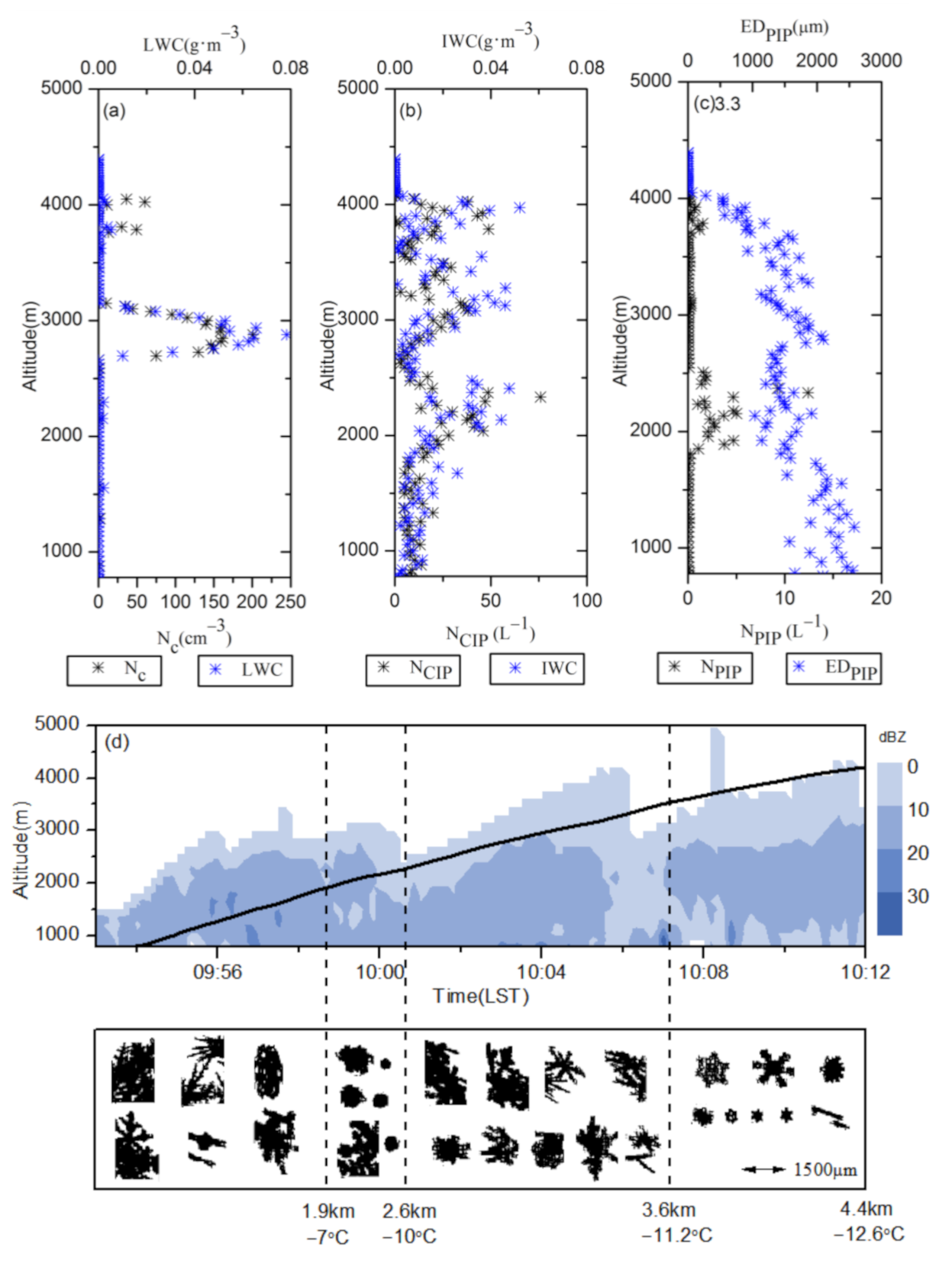
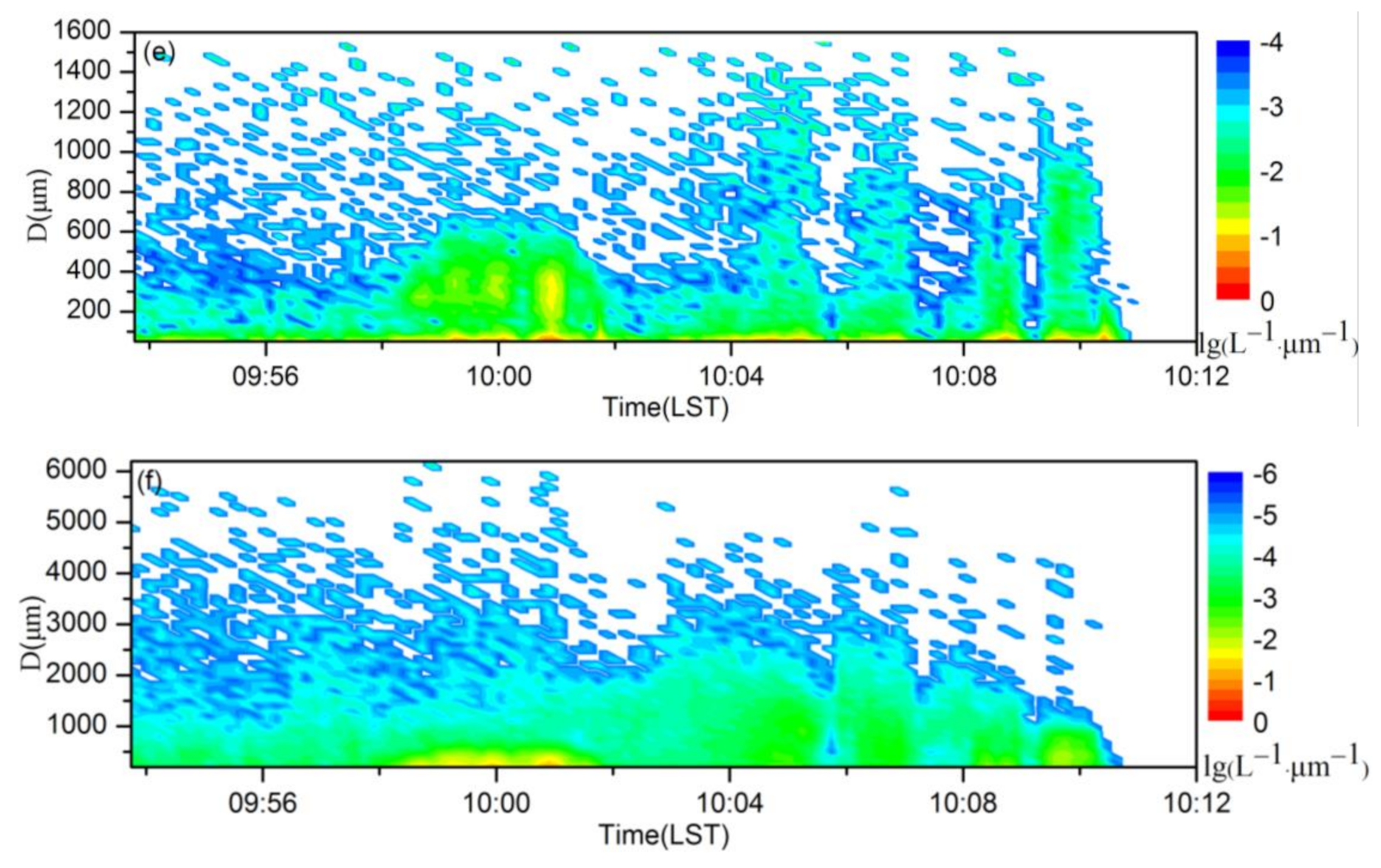
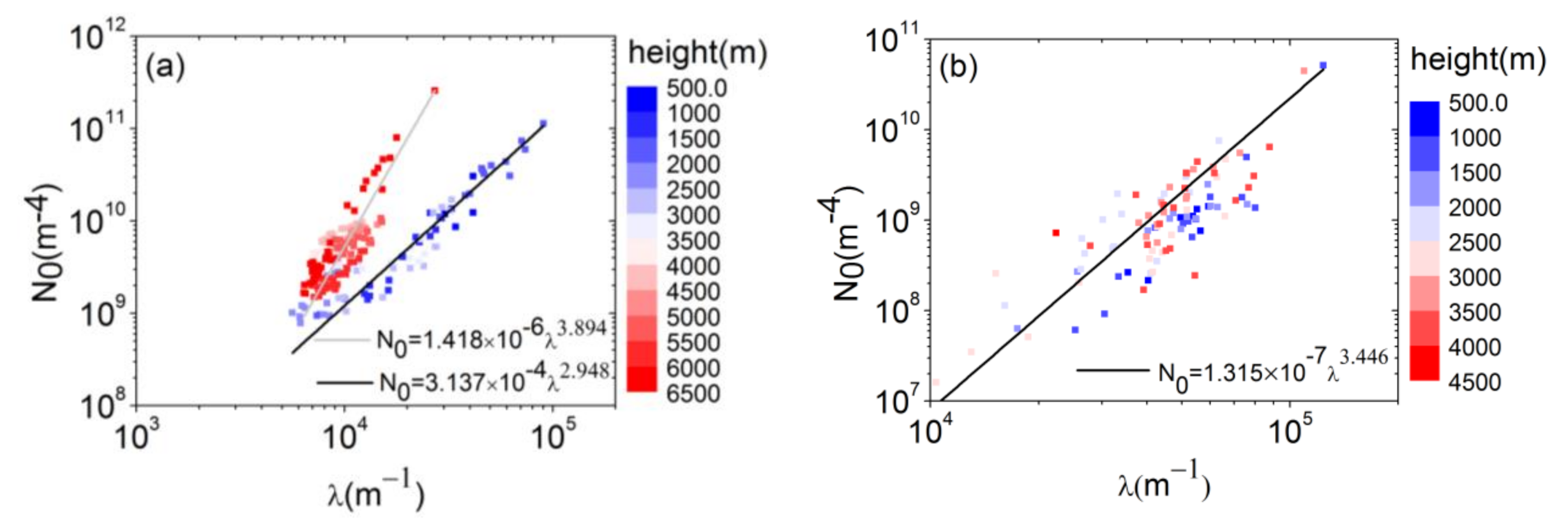

Publisher’s Note: MDPI stays neutral with regard to jurisdictional claims in published maps and institutional affiliations. |
© 2021 by the authors. Licensee MDPI, Basel, Switzerland. This article is an open access article distributed under the terms and conditions of the Creative Commons Attribution (CC BY) license (https://creativecommons.org/licenses/by/4.0/).
Share and Cite
Feng, Q.; Niu, S.; Hou, T.; Yue, Z.; Shen, D. Aircraft Observations of Characteristics and Growth of Ice Particles of Two Different Snowfall Clouds in Shanxi Province, China. Atmosphere 2021, 12, 477. https://doi.org/10.3390/atmos12040477
Feng Q, Niu S, Hou T, Yue Z, Shen D. Aircraft Observations of Characteristics and Growth of Ice Particles of Two Different Snowfall Clouds in Shanxi Province, China. Atmosphere. 2021; 12(4):477. https://doi.org/10.3390/atmos12040477
Chicago/Turabian StyleFeng, Qiujuan, Shengjie Niu, Tuanjie Hou, Zhiguo Yue, and Dongdong Shen. 2021. "Aircraft Observations of Characteristics and Growth of Ice Particles of Two Different Snowfall Clouds in Shanxi Province, China" Atmosphere 12, no. 4: 477. https://doi.org/10.3390/atmos12040477
APA StyleFeng, Q., Niu, S., Hou, T., Yue, Z., & Shen, D. (2021). Aircraft Observations of Characteristics and Growth of Ice Particles of Two Different Snowfall Clouds in Shanxi Province, China. Atmosphere, 12(4), 477. https://doi.org/10.3390/atmos12040477





